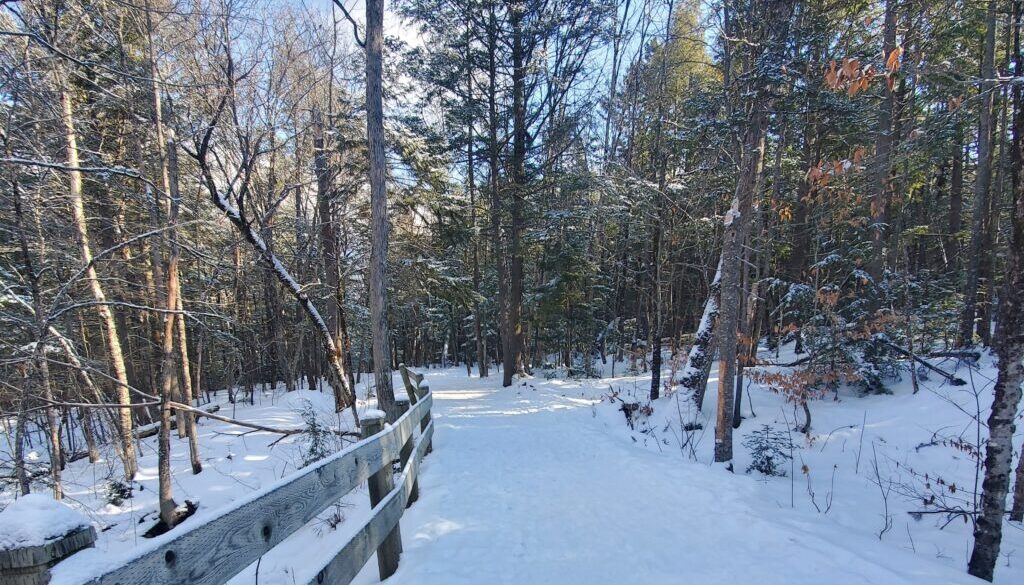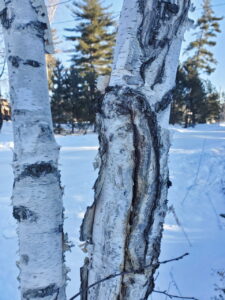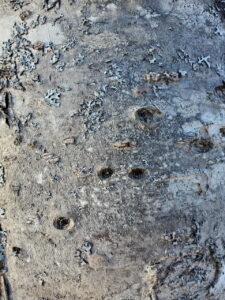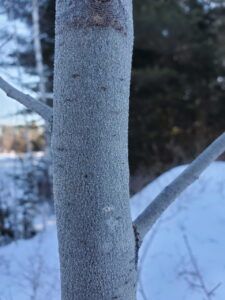Exploring your 5 senses in the forest in the winter
By Danielle Hak and Emily Ruttan
For many of us living in New Brunswick, the amount of time we spend outside in the winter months dramatically decreases. There are many reasons why staying inside your warm home is appealing at this time of year, but there are so many things to experience in the forest in winter that are unlike at any other time of the year.
As the days start to get slightly longer, but winter weather continues, now is a perfect time to get out, explore a forest near you and take in all of its winter beauty. As you are able, and when it is safe to do so, take some time to explore all your senses. The forest provides so many wonderful opportunities to experience each of your senses and more deeply connect to the environment around you. We recommend bringing a notebook/journal to record some of the senses you experience and how you feel being still and present in nature.
- Hear
Have you ever noticed the quiet sensation of the forest in the winter? There is a distinct absence of noises, movements, and songs that you might hear other times of the year. Temperature plays a big role in the movement of sound waves, and sound moves slower through colder air, making it easier to hear noises from further away[1]. On your next trip into the forest, take a moment to be silent and observe what you hear around you.
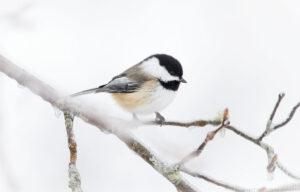
Winter in the forest is a beautiful time to listen to bird’s songs! While you might be able to hear more birds in the spring and summer, the winter provides a unique opportunity to listen to the calls of birds that do not migrate with the seasons.
While you are on a hike, tap into your sense of sound, to listen to the birds around you. What kinds of songs do you hear? Are there many birds, calling to each other, or a few marking their territory? Do they sound playful and upbeat, or distressed, possibly warning of danger? Are they long calls, or short chirps? These distinctions can tell you a lot about what bird you are listening to.
Identifying bird calls is an impressive skill to master, but with a bit of practice, and quiet time listening in nature, you can begin to hear the different sounds that make each bird species unique.
- See
Sight is the predominant sense that most people rely on when out in the forest. But how often do you take a closer look off the trail, to see what is hiding deeper in the forest? While snow buries many plants and wildlife close to the ground in the winter months, there are still many animals that are active when temperatures drop. While many people believe that animals go into a full sleep for the winter, very few animals are true hibernators (meaning they are dormant through the entire winter) and most maintain some level of activity in the winter to find food, find shelter and protect themselves.
Many animals that remain active in the winter months have adapted to camouflage into their surroundings. The snowshoe hare is one example of this, where in spring and summer they can be observed with brown hair, but shed the brown for a white coat in the winter, to better blend in with the snow. Instead of direct animal signings, next time you are out in the forest, put your detective skills to the test and look for other signs of wildlife.
Some indicators that an animal might be nearby include tracks in the snow, animal scat, remains of nests or dens, and shedding of fur or feathers. Remember, it is always important to keep your distance from animals, and not disturb them while you are in their home.
- Smell
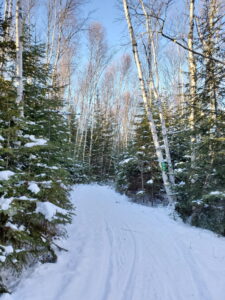
Take a deep breath in. Not only can this help you relax, but you may also notice some different scents in the forest! You may notice the towering Pine trees, the winding Cedars, the conical Spruces, and the narrow Firs. At first, they may smell the same, but the coniferous trees in New Brunswick have some unique aromas!
Trees and plants get their scents from chemical compounds called Terpenes. Each tree has its own special make-up of terpenes, which not only give trees their scent, but it also acts as a deterrent to insects and some types of fungi[2]! Test and see if you can smell the difference between the conifers!
Do any of these scents remind you of anything you may keep in your home? Some may remind you of the Holiday season. Pine trees, Spruce trees and Balsam Fir are often used as Christmas trees and used to make wreaths and garlands as festive decorations! You may also recognize cedar as it is very fragrant and one of the four sacred medicines used in Indigenous cultures for smudging.
- Taste
When was the last time you tried to catch snowflakes on your tongue? In heavy snowfalls, we often try to keep our head down, avoiding winds and snow on our face, but you could be missing some of the beauty that is unfolding around you. This classic childhood activity of catching snowflakes is fun for all ages and can be quite a peaceful way to spend your time in the forest.
If you find yourself on a forest walk during a snowfall, try to stand as still as you can and see how many snowflakes you can catch. Notice how cold it is around you, as you monitor your breath in the frosty air.
This is an especially fun activity during snowfalls with large snowflakes. Did you know that a snowflake’s size correlates to the temperature? As snow crystals fall, many can collide together, giving the appearance of larger snowflakes. This is most likely to happen right around freezing (0 degrees Celsius) because as the temperature gets colder the snow crystals are drier and less likely to stick together, making snowflakes look smaller[3].
- Touch
Look around at all the trees. Some may have dropped their leaves; some may still have their needles, but no matter what happens in the winter, all trees keep their bark! Have you ever noticed the differences between the bark? Have you ever seen the different patterns and textures? Can you feel the difference between them?
Most trees have unique differences in their bark that distinguish them from each other, even if it may not be obvious at first. For example, both Aspen and Birch trees have similar white bark, but Birch has lots of little pores called “lenticels” and the bark often peels away from the tree. Other trees have defining patterns, like Ash trees that have deep diamond ridges in the bark, or Ironwood trees that have long strips of bark that are loose at either end.
Take some time to explore trees through touch and note any differences in patterns, edges, textures, bumps, and thickness. It is best to be careful when touching the trees, so as not to cut yourself on anything sharp, like any twigs or Spruce needles. It is also best to bring hand sanitizer to clean your hands after feeling the tree bark. Some trees might leave you with sticky sap residue on your hands, but this is all a part of the fun of exploring different trees!
Close up photos of tree Bark (from left to right): White Birch, Mountain Ash, Trembling Aspen
Photo credit: Emily Ruttan
If you go out on a 5-senses walk, we would love to hear about it. Tag us on Facebook (@CPAWSNewBrunswick) or Instagram (@cpawsnb) and share your experience. While you are out in nature, remember to always pay attention to where you are, avoid stepping on any wildlife, and do not intentionally disturb the habitat. This includes picking plants, removing bark, or chasing any animals. It is especially important to keep your distance from any animals you might encounter.
We hope you are inspired to get outside this winter and cannot wait to hear about all what our supporters have found in the forests near them!
Sources:
[1] https://www.discovery.com/science/Sound-Carries-Farther-Cold-Days
[2] https://earthsky.org/earth/why-conifer-christmas-trees-pine-spruce-fir-smell-terpenes/
[3] https://weather.com/safety/winter/news/2020-02-10-snowflake-size-difference-large-wet-small-dry

